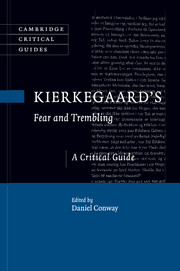Book contents
- Frontmatter
- Contents
- List of Contributors
- Acknowledgments
- List of Abbreviations
- Introduction
- Chapter 1 Homing in on Fear and Trembling
- Chapter 2 Fear and Trembling’s “Attunement” as midrash
- Chapter 3 Johannes de silentio’s dilemma
- Chapter 4 Can an admirer of silentio’s Abraham consistently believe that child sacrifice is forbidden?
- Chapter 5 Eschatological faith and repetition: Kierkegaard’s Abraham and Job
- Chapter 6 The existential dimension of faith
- Chapter 7 Learning to hope: the role of hope in Fear and Trembling
- Chapter 8 On being moved and hearing voices: passion and religious experience in Fear and Trembling
- Chapter 9 Birth, love, and hybridity: Fear and Trembling and the Symposium
- Chapter 10 Narrative unity and the moment of crisis in Fear and Trembling
- Chapter 11 Particularity and ethical attunement: situating Problema III
- Chapter 12 ‘He speaks in tongues’: hearing the truth of Abraham’s words of faith
- Chapter 13 Why Moriah?: weaning and the trauma of transcendence in Kierkegaard’s Fear and Trembling
- Bibliography
- Index
Chapter 2 - Fear and Trembling’s “Attunement” as midrash
Published online by Cambridge University Press: 05 February 2015
- Frontmatter
- Contents
- List of Contributors
- Acknowledgments
- List of Abbreviations
- Introduction
- Chapter 1 Homing in on Fear and Trembling
- Chapter 2 Fear and Trembling’s “Attunement” as midrash
- Chapter 3 Johannes de silentio’s dilemma
- Chapter 4 Can an admirer of silentio’s Abraham consistently believe that child sacrifice is forbidden?
- Chapter 5 Eschatological faith and repetition: Kierkegaard’s Abraham and Job
- Chapter 6 The existential dimension of faith
- Chapter 7 Learning to hope: the role of hope in Fear and Trembling
- Chapter 8 On being moved and hearing voices: passion and religious experience in Fear and Trembling
- Chapter 9 Birth, love, and hybridity: Fear and Trembling and the Symposium
- Chapter 10 Narrative unity and the moment of crisis in Fear and Trembling
- Chapter 11 Particularity and ethical attunement: situating Problema III
- Chapter 12 ‘He speaks in tongues’: hearing the truth of Abraham’s words of faith
- Chapter 13 Why Moriah?: weaning and the trauma of transcendence in Kierkegaard’s Fear and Trembling
- Bibliography
- Index
Summary
It has been well observed that Johannes de Silentio offers in Fear and Trembling “his own version of a midrash on Abraham’s struggle,” and several scholars have explored the relationship between his reflections on this struggle and the tradition of rabbinic midrash, or scriptural interpretation. Yet there is more work to be done in this area, and not simply for philological reasons. In particular, I believe that the multiple narratives of the first chapter of Fear and Trembling, entitled Stemning or “Attunement,” can – and should – be read as midrash, and studied in relation to the very different versions of the Akedah (the scriptural narrative of Abraham’s near sacrifice of Isaac) that are recorded in the Jewish tradition. This chapter aims to show that reading “Attunement” as midrash can illuminate the problem of faith in Fear and Trembling, and perhaps even enrich our understanding of the Akedah itself.
In at least one essential respect, “Attunement” presents Fear and Trembling in microcosm: it tells the story of an anonymous man who – like Silentio – tries to understand the faith that Abraham displays in the Akedah, but is unable to do so. What is the point of Silentio’s story? To what is it supposed to “attune” the reader? What accounts for the interpretative failure of its protagonist (hereafter referred to as “the exegete”)? How might it be related to Silentio’s own failure to understand Abraham? These basic questions motivate the present inquiry.
- Type
- Chapter
- Information
- Kierkegaard's Fear and TremblingA Critical Guide, pp. 26 - 43Publisher: Cambridge University PressPrint publication year: 2015
- 1
- Cited by



